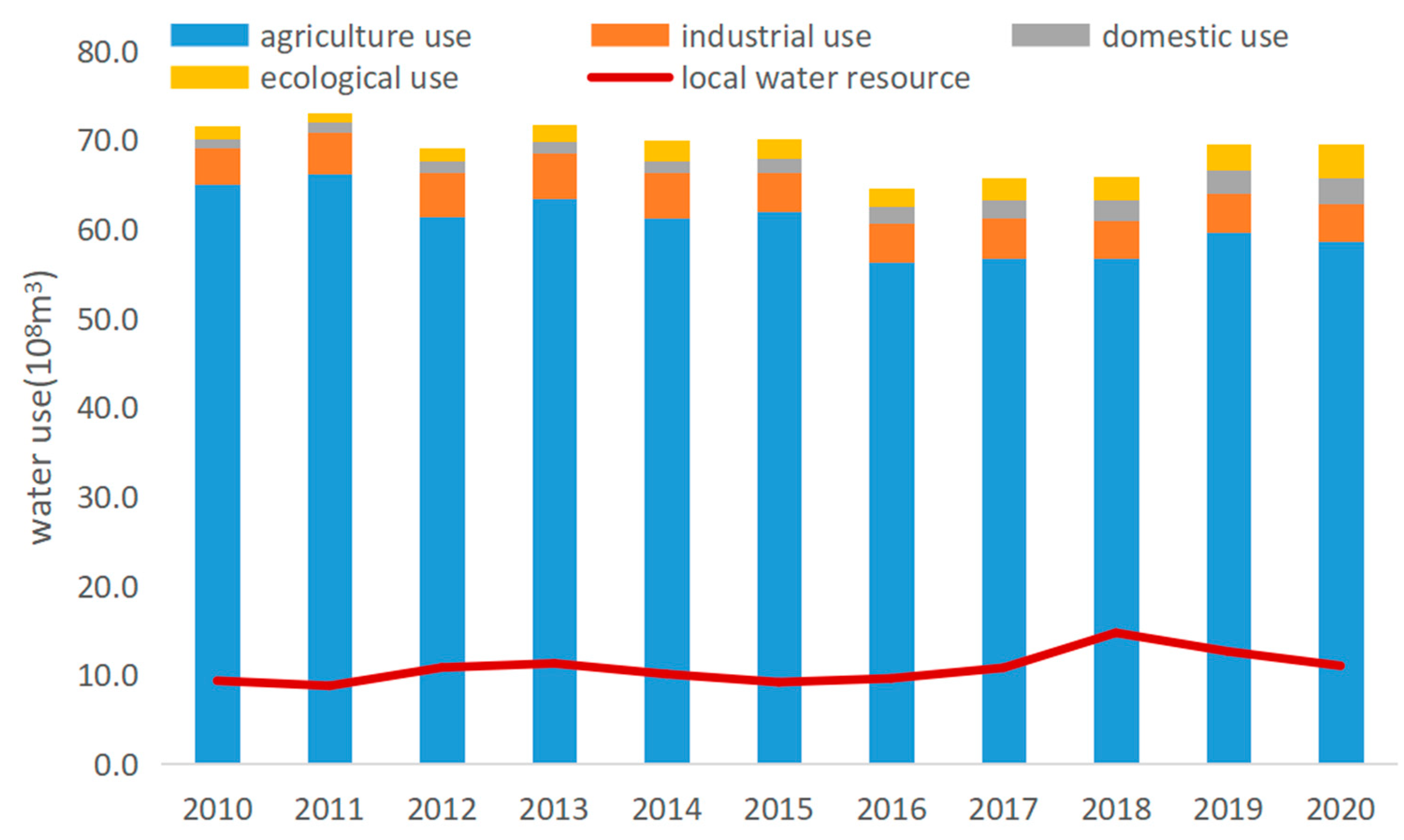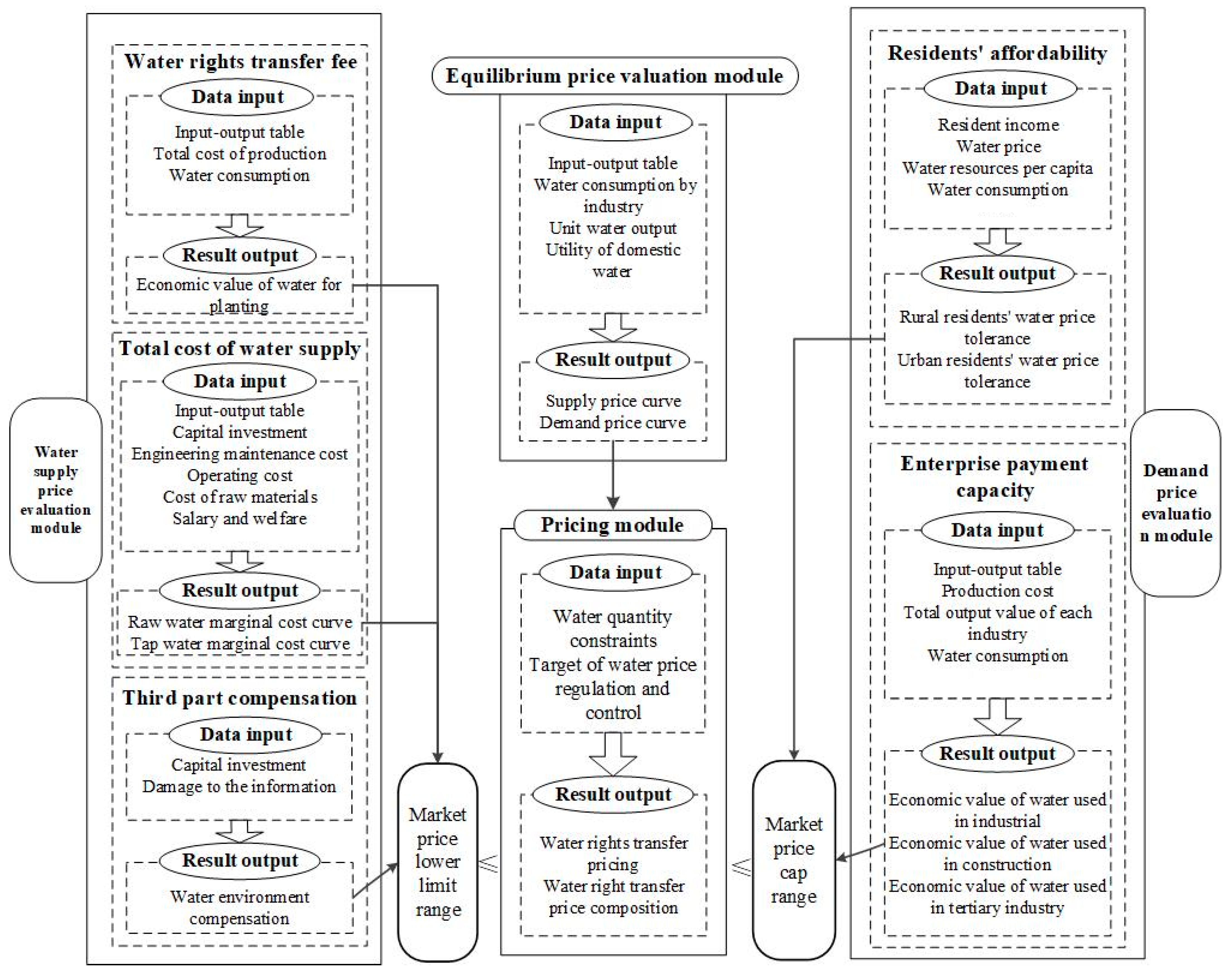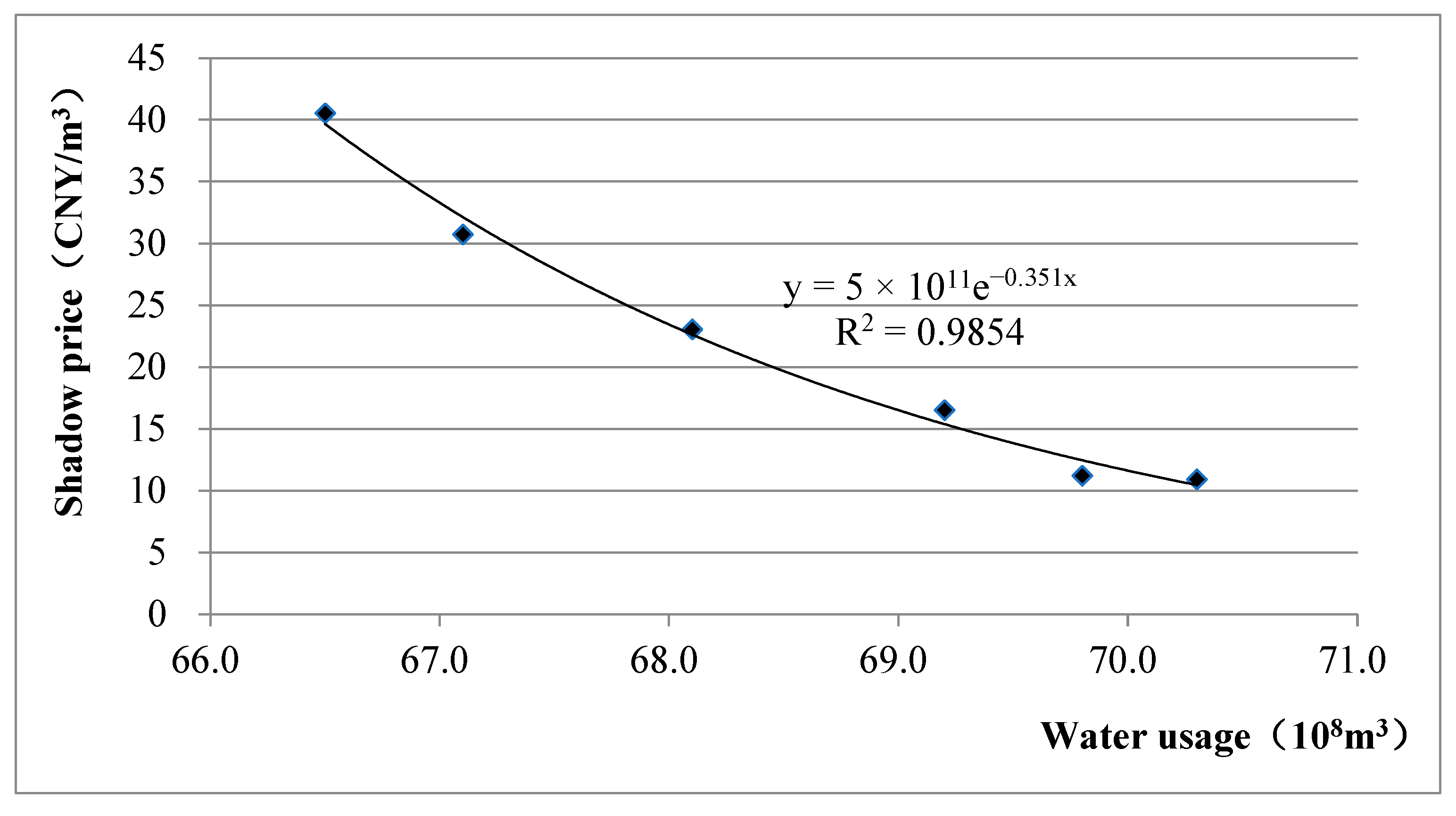Research on Water Rights Trading and Pricing Model between Agriculture and Energy Development in Ningxia, China
Abstract
1. Introduction
2. Materials and Methods
2.1. Study Area
2.2. The Water Rights Transfer Price Model
2.2.1. The Structure of the Model
2.2.2. Supply Price Evaluation Module
- (1)
- Evaluation method of water rights transfer fee
- (2)
- Evaluation method for the total cost of water supply
- (3)
- Evaluation method of compensation price
2.2.3. The Demand Price Evaluation Module
2.2.4. The Equilibrium Price Evaluation Module
2.3. Data
3. Results
3.1. Supply Price of Supply Side
3.1.1. Water Rights Transfer
3.1.2. Total Cost of Water Supply
3.1.3. Compensation Price of the Third Parties
3.2. Demand Price of Demand Side
3.3. The Equilibrium Price Based on Market Trading Pattern
3.4. Payment Standard
4. Discussion
4.1. Rationality Analysis
4.2. Comparative Analysis
4.3. Policy Implications
5. Conclusions
Author Contributions
Funding
Institutional Review Board Statement
Informed Consent Statement
Acknowledgments
Conflicts of Interest
References
- The United Nations. World Water Development Report 2015-Water for a Sustainable World; The United Nations Educational, Scientific and Cultural Organization: Paris, France, 2019. [Google Scholar]
- The United Nations. World Water Development Report 2019-Leaving No One Behind; The United Nations Educational, Scientific and Cultural Organization: Paris, France, 2019. [Google Scholar]
- Chang, Y.; Li, G.; Yao, Y.; Zhang, L.; Yu, C. Quantifying the water-energy-food nexus: Current status and trends. Energies 2016, 9, 65. [Google Scholar] [CrossRef]
- Zhang, P.; Zhang, L.; Chang, Y.; Xu, M.; Hao, Y.; Liang, S.; Liu, G.; Yang, Z.; Wang, C. Food-energy-water (FEW) nexus for urban sustainability: A comprehensive review. Resour. Conserv. Recycl. 2019, 142, 215–224. [Google Scholar] [CrossRef]
- Hoff, H. Understanding the nexus. In Proceedings of the Background Paper for the Bonn 2011 Conference: The Water, Energy and Food Security Nexus Stockholm, Bonn, Germany, 16–18 November 2011. [Google Scholar]
- Adnan, H. Water, Food, and Energy Nexus in Asia and the Pacific; United Nations Economic and Social Commission for Asia and the Pacific: Bangkok, Thailand, 2013. [Google Scholar]
- Bieber, N.; Ker, J.H.; Wang, X.; Triantafyllidis, C.; van Dam, K.H.; Koppelaar, R.H.E.M.; Shah, N. Sustainable planning of the energy-water-food nexus using decision making tools. Energy Policy 2018, 113, 584–607. [Google Scholar] [CrossRef]
- He, C.; Harden, C.P.; Liu, Y. Comparison of water resources management between China and the United States. Geogr. Sustain. 2020, 1, 98–108. [Google Scholar] [CrossRef]
- Ghosh, S.; Cobourn, K.M.; Elbakidze, L. Water banking, conjunctive administration, and drought: The interaction of water markets and prior appropriation in southeastern Idaho. Water Resour. Res. 2015, 50, 6927–6949. [Google Scholar] [CrossRef]
- Maggioni, E. Water demand management in times of drought: What matters for water conservation. Water Resour. Res. 2015, 51, 125–139. [Google Scholar] [CrossRef]
- Grantham, T.E.; Viers, J.H. 100 years of California’s water rights system: Patterns, trends and uncertainty. Environ. Res. Lett. 2014, 9, 084012. [Google Scholar] [CrossRef]
- Berck, P.; Lipow, J. Real and ideal water rights: The prospects for water-rights reform in Israel, Gaza, and the West Bank. Resour. Energy Econ. 1994, 16, 287–301. [Google Scholar] [CrossRef]
- Murthy, S.L.; Williams, M.; Baskin, E. The Human Right to Water in Israel: A Case Study of the Unrecognised Bedouin Villages in the Negev. Isr. Law Rev. 2012, 46, 25–59. [Google Scholar] [CrossRef]
- Poirier, R.; Schartmueller, D. Indigenous water rights in Australia. Soc. Sci. J. 2012, 49, 317–324. [Google Scholar] [CrossRef]
- Mckay, J. Water institutional reforms in Australia. Water Policy 2005, 7, 35–52. [Google Scholar] [CrossRef]
- Brennan, D. Water policy reform in Australia: Lessons from the Victorian seasonal water market. Aust. J. Agric. Resour. Econ. 2006, 50, 403–423. [Google Scholar] [CrossRef]
- Bauer, C.J. Results of Chilean water markets: Empirical research since 1990. Water Resour. Res. 2004, 40, 6–9. [Google Scholar] [CrossRef]
- Wang, Y.B.; Liu, D.; Cao, X.; Yang, Z.; Song, J.; Chen, D.; Sun, S. Agricultural water rights trading and virtual water export compensation coupling model: A case study of an irrigation district in China. Agric. Water Manag. 2017, 180, 99–106. [Google Scholar] [CrossRef]
- Nguyen-Ky, T.; Mushtaq, S.; Loch, A.; Reardon-Smith, K.; An-Vo, D.A.; Ngo-Cong, D.; Tran-Cong, T. Predicting water allocation trade prices using a hybrid Artificial Neural Network-Bayesian modelling approach. J. Hydrol. 2018, 567, 781–791. [Google Scholar] [CrossRef]
- Bjornlund, H.; Rossini, P. Fundamentals Determining Prices in the Market for Water Entitlements: An Australian Case Study. Int. J. Water Resour. Dev. 2007, 23, 537–553. [Google Scholar] [CrossRef]
- Cui, J.; Schreider, S. Modelling of pricing and market impacts for water options. J. Hydrol. 2009, 371, 31–41. [Google Scholar] [CrossRef]
- Colby, B.G.; Crandall CBush, D. Water right transactions: Market values and price dispersion. Water Resour. Res. 1993, 29, 1565–1572. [Google Scholar]
- Zhong, L.J.; Mol, A.P.J. Water price reforms in China: Policy-making and implementation. Water Resour. Manag. 2010, 24, 377–396. [Google Scholar] [CrossRef]
- Yoo, J.; Simonit, S.; Connors, J.P.; Maliszewski, P.J.; Kinzig, A.P.; Perrings, C. The value of agricultural water rights in agricultural properties in the path of development. Ecol. Econ. 2013, 91, 57–68. [Google Scholar] [CrossRef]
- Meinzen-Dick, R. Property rights and sustainable irrigation: A developing country perspective. Agric. Water Manag. 2014, 145, 23–31. [Google Scholar] [CrossRef]
- Michelsen, A.M.; Young, R.A. Optioning Agricultural Water Rights for Urban Water Supplies during Drought. Am. J. Agric. Econ. 1993, 75, 1010–1020. [Google Scholar] [CrossRef]
- Matthews, O.P. Fundamental questions about water rights and market reallocation. Water Resour. Res. 2004, 40, W09S08. [Google Scholar] [CrossRef]
- Hang, Z.A.; Yl, A.; Jz, B. Understanding water rights and water trading systems in China: A systematic framework. Water Secur. 2021, 13, 100094. [Google Scholar]
- Wang, Y. A simulation of water markets with transaction costs. Agric. Water Manag. 2012, 103, 54–61. [Google Scholar] [CrossRef]
- He, G.; Liu, H.; Wang, J.; Zhao, Y.; Zhu, Y.; Jiang, S.; Li, H.; Zhai, J.; He, F. Energy-water security challenge: Impact of energy production on water sustainable developments in Northwest China in 2017 and 2030. Sci. Total Environ. 2021, 766, 144606. [Google Scholar] [CrossRef]
- Liu, Y.; Lin, Y.; Huo, Z.; Zhang, C.; Wang, C.; Xue, J.; Huang, G. Spatio-temporal variation of irrigation water requirements for wheat and maize in the Yellow River Basin, China, 1974–2017. Agric. Water Manag. 2022, 262, 107451. [Google Scholar] [CrossRef]
- Zhang, H.; Zhou, Q.; Zhang, C. Evaluation of agricultural water-saving effects in the context of water rights trading: An empirical study from China’s water rights pilots. J. Clean. Prod. 2021, 313, 127725. [Google Scholar] [CrossRef]
- Lange, G.M.; Hassan, R. The Economics of Water Management in Southern Africa: An Environmental Accounting Approach; Edward Elgar Publishing: Cheltenham, UK, 2006. [Google Scholar]
- Ziolkowska, J.R. Shadow price of water for irrigation—A case of the High Plains. Agric. Water Manag. 2015, 153, 20–31. [Google Scholar] [CrossRef]
- Kiprop, J.K.; Lagat, J.K.; Mshenga, P.; Macharia, A.M. Determining the Economic Value of Irrigation Water in Kerio Valley Basin (Kenya) by Residual Value Method. J. Econ. Sustain. Dev. 2015, 6, 102–107. [Google Scholar]
- Sani, Y.; Scholz, M. Gender and Other Vulnerabilities to Water–Energy Accessibility in Rural Households of Katsina State, Northern Nigeria. Sustainability 2022, 14, 7499. [Google Scholar] [CrossRef]
- Han, X.; Zhao, Y.; Gao, X.; Jiang, S.; Lin, L.; An, T. Virtual water output intensifies the water scarcity in Northwest China: Current situation, Problem analysis and Countermeasures. Sci. Total Environ. 2020, 765, 144276. [Google Scholar] [CrossRef]





| Type | Data Sources |
|---|---|
| Agricultural water consumption data | Water Resources Bulletin |
| Economic input–output table | Ningxia Municipal Bureau of Statistics |
| Per capita water consumption data | China Water Resources Bulletin |
| Total economic output value of each industry | China Census yearbook |
| Industrial departments’ water consumption data | China Economic Census Yearbook |
| Total industrial water consumption data | Water Resources Bulletin |
| Amount of water transferred | Ningxia Water Rights Transfer Strategy |
| Water resources fee and the supply price of tap | Field investigation |
| Agriculture | Industry | Construction | Transportation and Telecommunication | Wholesale, Retail and Catering | Others | |
|---|---|---|---|---|---|---|
| Agriculture | 0.106297 | 0.032172 | 0.000117 | 0.000169 | 0.040212 | 0.000822 |
| Industry | 0.330951 | 0.597750 | 0.511464 | 0.295029 | 0.173550 | 0.159409 |
| Construction | 0.000000 | 0.000741 | 0.011854 | 0.001136 | 0.002244 | 0.003488 |
| Transportation and telecommunication | 0.014146 | 0.044423 | 0.081294 | 0.096388 | 0.029240 | 0.023158 |
| Wholesale, retail and catering | 0.028051 | 0.015072 | 0.096499 | 0.013575 | 0.018824 | 0.052562 |
| Others | 0.003606 | 0.043308 | 0.026648 | 0.091977 | 0.091717 | 0.158298 |
| Variables | (108 CNY) | (108 CNY) | (108 CNY) | (108 CNY) | (m3/104 CNY) | ||
|---|---|---|---|---|---|---|---|
| Industry | |||||||
| Agriculture | 231.4 | 462.9 | 119.6 | 70.0 | 0.0546 | 3193.62 | |
| Industry | 1977.9 | 3955.8 | 527.2 | 5.0 | 0.0363 | 49.54 | |
| Construction | 619.0 | 1238.0 | 168.4 | 0.5 | 0.0599 | 3.21 | |
| Transportation and telecommunication | 235.0 | 470.0 | 117.9 | 0.5 | 0.0353 | 2.12 | |
| Wholesale, retail and catering | 157.7 | 315.4 | 101.6 | 0.5 | 0.0615 | 7.68 | |
| Others | 620.4 | 1240.8 | 373.6 | 0.5 | 0.1581 | 5.6 | |
| Type | Water Price (CNY/m3) |
|---|---|
| Water rights transfer | 0.57 |
| Cost of water supply | 3.3 |
| Compensation price of the third parties | 1.65 |
| Supply price | 5.52 |
| Demand price | 37.6 |
| Equilibrium price | 10.91~40.52 |
Publisher’s Note: MDPI stays neutral with regard to jurisdictional claims in published maps and institutional affiliations. |
© 2022 by the authors. Licensee MDPI, Basel, Switzerland. This article is an open access article distributed under the terms and conditions of the Creative Commons Attribution (CC BY) license (https://creativecommons.org/licenses/by/4.0/).
Share and Cite
Qin, C.; Jiang, S.; Zhao, Y.; Zhu, Y.; Wang, Q.; Wang, L.; Qu, J.; Wang, M. Research on Water Rights Trading and Pricing Model between Agriculture and Energy Development in Ningxia, China. Sustainability 2022, 14, 15748. https://doi.org/10.3390/su142315748
Qin C, Jiang S, Zhao Y, Zhu Y, Wang Q, Wang L, Qu J, Wang M. Research on Water Rights Trading and Pricing Model between Agriculture and Energy Development in Ningxia, China. Sustainability. 2022; 14(23):15748. https://doi.org/10.3390/su142315748
Chicago/Turabian StyleQin, Changhai, Shan Jiang, Yong Zhao, Yongnan Zhu, Qingming Wang, Lizhen Wang, Junlin Qu, and Ming Wang. 2022. "Research on Water Rights Trading and Pricing Model between Agriculture and Energy Development in Ningxia, China" Sustainability 14, no. 23: 15748. https://doi.org/10.3390/su142315748
APA StyleQin, C., Jiang, S., Zhao, Y., Zhu, Y., Wang, Q., Wang, L., Qu, J., & Wang, M. (2022). Research on Water Rights Trading and Pricing Model between Agriculture and Energy Development in Ningxia, China. Sustainability, 14(23), 15748. https://doi.org/10.3390/su142315748








